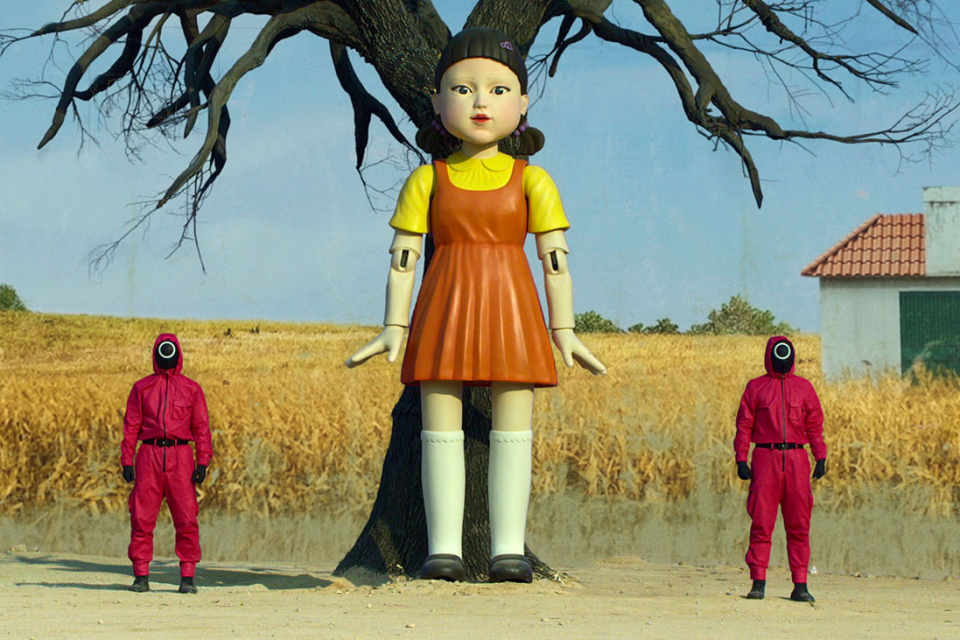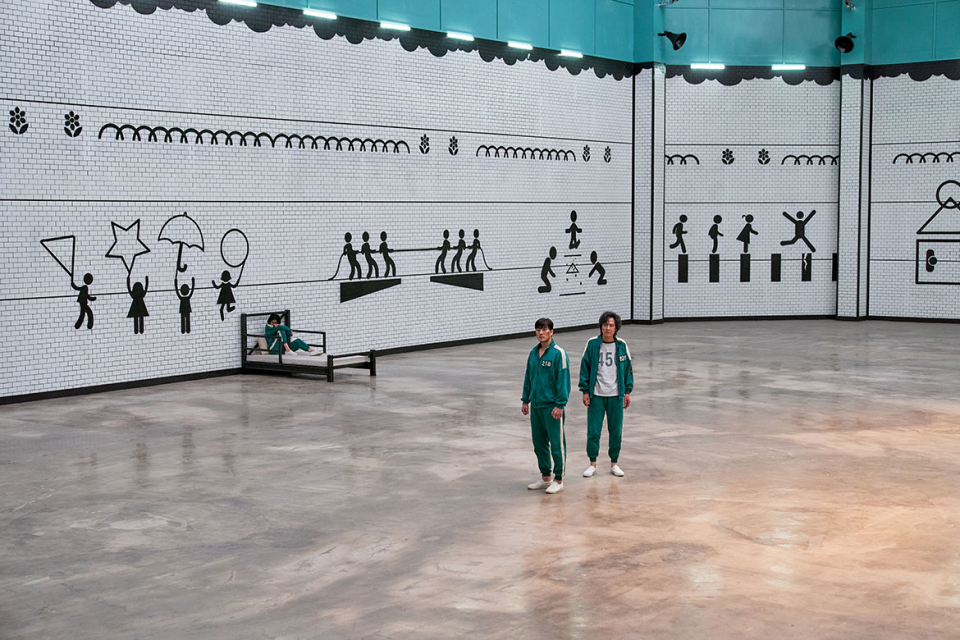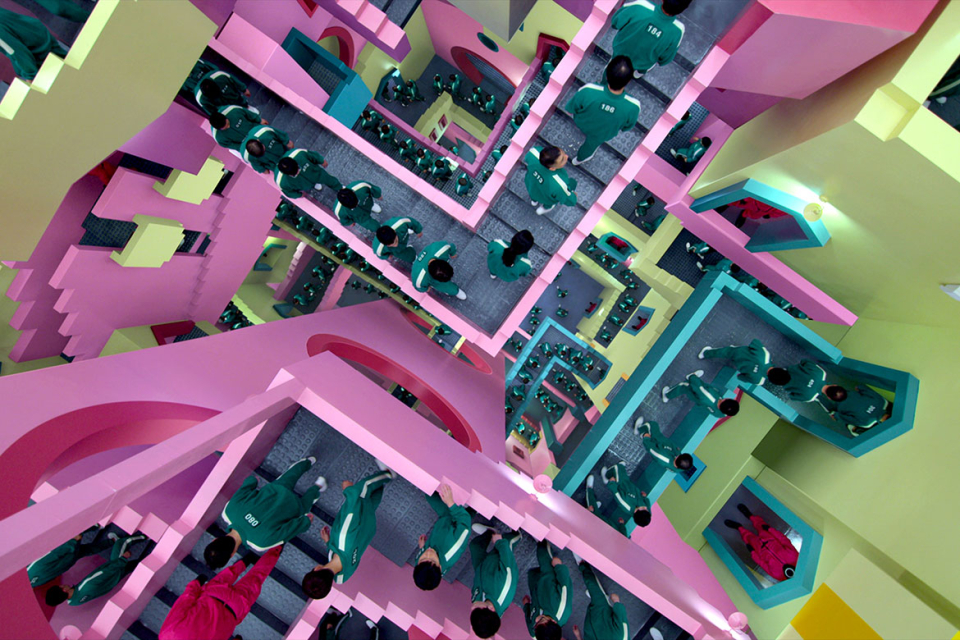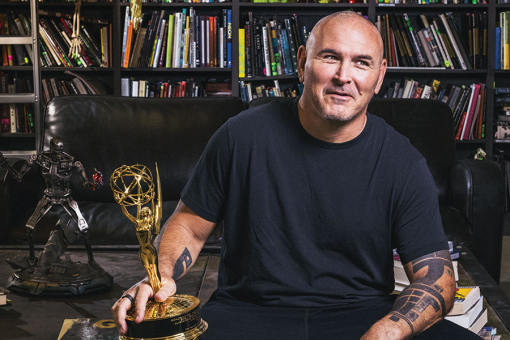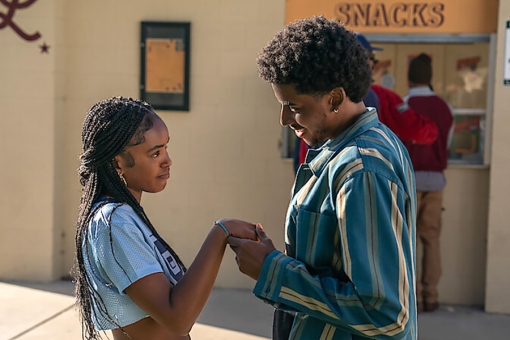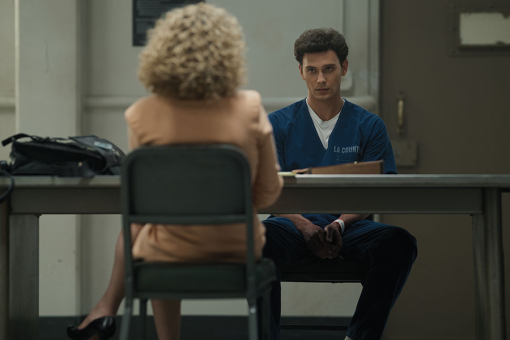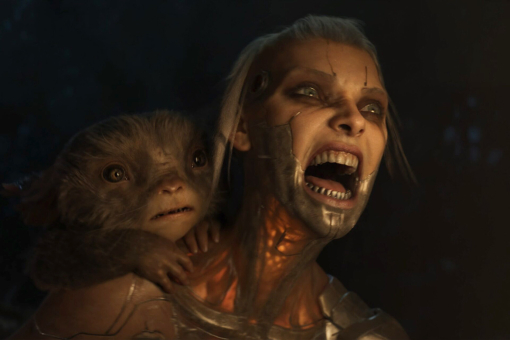At a moment when economic unease can seem as pervasive as Covid-19, it was perhaps inevitable that Squid Game would capture the global Zeitgeist. The Netflix show's grabber premise: Enticed by a winner-take-all jackpot of $38 million in cash, 456 financially strapped people agree to compete in a series of children's games — with grisly consequences for the losers.
Writer-director Hwang Dong-hyuk's heady brew of desperation, nihilism — and, for the glass-half-empty crowd, coal-black comedy — has attracted an audience so large that, in an interview shortly after Squid Game's September 17 premiere, Ted Sarandos, Netflix's co-chief executive officer and chief content officer, said, "There's a very good chance it will be our biggest show ever."
That speculation became reality shortly afterward.
One of Squid Game's most vivid elements is its production design, especially the depiction of the island compound where the competitors are housed and the games are played. When conceiving the look of the show, art director Chae Kyung-sun drew inspiration from a variety of sources — from coloring books to South Korean building materials of the 1970s and '80s — to achieve an effect that was both innovative and nostalgic. Here, speaking through a translator, she explains.
Based on watching the series, it seems like there was almost no CGI involved.
You're very correct. We tried to minimize the computer graphics. Because there are 456 participants, and I wanted them to act as if they were really in the game and that they felt like they were in the game. We wanted to make it really realistic for them, so we made everything to scale.
Where did you build everything?
We rented the three biggest studios in Korea for seven or eight months, which was our production timeline. I apologize to the other series makers, because they couldn't use the studios! Usually for the sets, it took about 30 to 45 days for us to build them, but for the aisle with the houses and the dormitory where all the 456 people lived, we needed to make sure that it was safe and secure, so that took about two months to build.
When writer-director Hwang Dong-hyuk approached to you about the project, what did you think?
I've worked with director Hwang on different movies, so I always have trust in him. I thought this was going to be fun, since I heard that he was planning to make it into a series, and I know he always lets me maneuver with my ideas and really unleash my full potential as art director. So, when I got the scenario and I talked with director Hwang, he wanted it to be like a Korean fantasy that is kind of like a cruel fairy tale.
My goal was to make some visuals that were something new to the Korean audience. I also wanted to be fantastical, but also very cruel at the same time, but also kind of challenged. I thought about this a lot with my team, how to make this possible. We looked at a lot of illustrations, we went to a lot of exhibits to get some ideas.
I wanted to go more analog than looking at, like, video material, so we looked at a lot of children's books and coloring books and those kinds of books with illustrations.
Korean children's books?
Yeah. I have a daughter, and she has a lot of children's books and coloring books, so I got a lot of inspiration from those. When I try to make some new type of video material, I always have to look at something else for inspiration, and for Squid Game, I think my focus was people. I think all the participants have their own history, they had their hardships, they had their troubles in life. So, I tried to really understand their feelings, and I thought about what kind of image comes to my mind when I think of their hardships, when they think of their troubles in life.
When I was driving, I felt the 456 participants were like people who are just left behind on the sides of the highway. So, some of my motifs were the highway and the tunnels. So, I used materials from the tunnels and the roads. I tried to kind of use the sense of space I have in my personal life, and I put them into Squid Game, and I think that kind of contrasts with the set. That kind of gave the audience an eerie feeling.
I think of the sets as so colorful and not as bridge-and-tunnel. What do you mean by that?
You are correct that most of the set is colorful, but when you look at the first scene where the dormitory appears and four masked men in pink overalls come in, they are under this arch, which is kind of like a tunnel. And the door they come in through is the same type of door we see in Korean tunnels in the rooms.
And the material that we used to build the set for the dormitory are white tiles that are used in building tunnels in Korea. And the pictograms that we used on the walls there? We also use that in tunnels to show the exit. So that was also inspired by the tunnel, and also for the tug-of-war game. I wanted to make sure that when they fall to the ground, the ground is like cold asphalt cement, so it kind of seems like the road where they were just left behind. And there's the yellow line that divides the road into two.
Then, if you look at the bunk beds in the dormitory, they're actually really high — like 11 meters high. So, I wanted to make it seem like kind of like Costco, where there are stacks of material. I wanted to objectify the people and make them seem like stacks of objects that are stacked on shelves. That's why I made the beds into a staircase kind of look, to show the social ladder. And most of the materials for the dormitory set came from white tiles which are used in tunnels.
Of all the games, which was most challenging for you to create and why?
All the sets were very challenging for me, but the most challenging in terms of safety was the tug-of-war set and the glass bridge set. But in terms of the timeline, how much effort I put into it, I think the most challenging was the marble game with the aisle and the houses and the doors. The reason why is because in Korea in the '70s and the '80s, on the aisle was like a children's playground. It's very symbolic. It symbolizes where children went to play; they just played in the aisles between their houses. So, I wanted to make sure that this raised a kind of nostalgia to the participants and to the audience as well.
I really looked at pictures in the '70s and '80s of the neighborhoods and the aisles, and I wanted to make sure the materials used — the stone, the grass, the doors — were all just like they were in the '70s and '80s. It took us a lot of time to make those one by one.
I also kind of wanted to make the neighborhood into a maze. So, if you open the door, there's another door. If you open that door, it leads to another door — so there's nothing but doors in that neighborhood. This was something that I also put a lot of time into, and I wanted to make sure that the set for the neighborhood would be on the verge of something real and something that's fake, because I think this episode shows the ambivalent feelings of the participants because they chose their best friend in the show, but they have to kill the other one in order for them to live. I wanted to portray the nostalgia. And the kind of hatred and feeling that they also have.
Most of the props that I needed for the '70s and '80s are not for sale anymore, so I had to make every single one of them by myself. That took a lot of time.
What kind of props from the '70s and '80s specifically?
First, in the '70s and '80s in Korea, we used coal to heat our houses — these black coals We don't use them anymore, so I had to go to the factory and get them tailor made. When you are finished using the coal, at first, it's black, but [later] it turns whitish gray. So, when you look at the scene, if someone dies, behind the person, there's the ashes. Not the black coal — the used coal. I located the used coal behind someone who's dead.
In the '70s and '80s, we also had milk delivery services in Korea, and they would hang the bags of milk on the doorknob, so I also made those milk delivery bags. Today we have a lot of apartments, but in the '70s and '80s, we had these houses, and beside the doors there would be little name pads. So, I also made the wooden name pads with either a circle, a triangle or square.
In the '70s and '80s, we also used a certain type of glass material for the windows, so I got those materials to use for the windows as well. So, there are a lot of props that I had to make by myself to make it look like that time.
For the tug-of-war, did the players climb as high as it looked on television?
For the tug-of-war, we had two sets. The first set was about 1.5 meters high, so it was safe enough for the actors to act, but it was a little bit high, so I also wanted them to feel a little scared. So, it was safe, but they [would be] 1.5 meters higher than the usual place that they stand.
We made another set, which was, like, 10 meters high, for a wire action, so the actors who did the wire action would act on the 10-meter-high set. So, we could use the 10-meter-high set to show the low angle, the top angle, how high the bridge was and the depth of the bridge.
What about the glass bridge?
We made a 1.5-meter-high glass bridge to scale, and we used that. We couldn't make the tall bridge because of safety issues. So, we made a separate [set with] just the floor for the glass bridge, and then we used a little bit of computer graphics in order to make it look real.
What did you think watching it all come together over the nine episodes?
This was my first time in a long [television] project — I always worked on films. This was the first time I put in so much time and effort. I really poured my heart into this. When the series was first out, I didn't really know what to feel. I just felt like, "Oh, it's actually out."
But then, after it became such a global hit, so many people are calling me, messaging me and congratulating me on what a big success it became, so I'm very happy. My parents are happy, my daughter's really proud of me. And I'm proud of myself. I'm really happy.
What happened to the "red light, green light" robot doll after the shoot?
There are a lot of issues with that robot. I had it designed with a special prop-making team called Geppetto Studios. First we made a miniature, then we made sure it worked and then we made it full up to scale.
The robot is now in in a city in Korea called Incheon, where they have their studio. Now it's so popular, so they have it well packaged inside their studio.
So maybe in season two we'll see it again!
Yes!
This interview has been edited for length and clarity
More articles celebrating Asian American & Pacific Islander Heritage Month.

